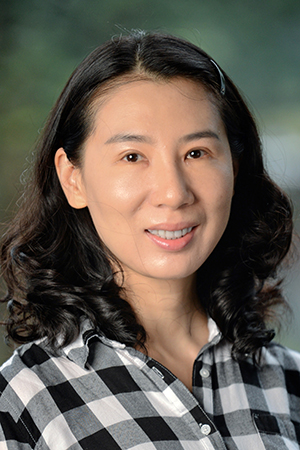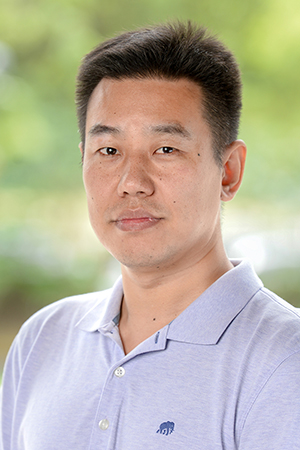NYU Shanghai, in partnership with the NYU Graduate School of Arts and Science and the NYU Center for Neural Science, invites applications from exceptional students for PhD study and research in Neural Science.
Participating students are enrolled in the NYU GSAS Neural Science PhD program, complete their coursework at the NYU Center for Neural Science in New York, and then transition to full-time residence at NYU Shanghai where they undertake their doctoral research under the supervision of NYU Shanghai faculty.
Highlights of the Program
- NYU degree upon graduation
- Graduate coursework at the NYU Center for Neural Science in New York
- Research opportunities with and close mentorship by NYU Shanghai faculty
- Access to the vast intellectual resources of NYU GSAS and NYU Center for Neural Science
- Cutting-edge research environment at NYU Shanghai, including the Institute of Brain and Cognitive Science, activities such as a regular program of seminars and visiting academics, a thriving community of PhD students, post-doctoral fellows, and research associates, and links with other universities within and outside China
- Financial aid through the NYU Shanghai Doctoral Fellowship, including tuition, fees, and an annual stipend
- Additional benefits exclusive to the NYU Shanghai program, including international health insurance, housing assistance in New York, and travel funds
Supervising Faculty

Li Li
Human Perception and Action, Eye-Hand Coordination, Virtual Reality

Sukbin Lim
Computational Neuroscience, Network Models for Learning and Memory

Zhong-Lin Lu
Visual Perception, Perceptual Learning, Attention, Amblyopia, Myopia, Adaptive Testing, Brain Imaging, Hierarchical Bayesian Models

Xing Tian
Speech and Language, Sensorimotor Integration and Transformation, Memory, Mental Imagery

Zhuo-Cheng Xiao
Computational Neuroscience, Visual Cortex, Hippocampus, Neural Oscillations
Recent Publications by NYU Shanghai Faculty
Xinying Cai
- Rustichini, A, Conen KE, Cai X and Padoa-Schioppa C (2017). "Optimal coding and neuronal adaptation in economic decisions." Nat Commun 8(1): 1208
- Murray JD, Bernacchia A, Freedman DJ, Romo R, Wallis JD, Cai X, Padoa-Schioppa C, Pasternak T, Seo H, Lee D, Wang XJ (2014) A hierarchy of intrinsic timescales across primate cortex. Nature Neuroscience 17, 1661–1663
Li Li
- Chen, R.R., Stone, L.S., & Li, L.* (2021). Visuomotor predictors of batting performance in baseball players. Journal of Vision, 21(3):3, 1–16, https://doi.org/10.1167/jov.21.3.3
- Kuai, S.*, Shan, Z.K.D., Chen, J., Xu, Z.X., Li, J.M., Field, D.T., & Li, L.* (2020). Integration of motion and form cues for the perception of self-motion in the human brain. Journal of Neuroscience, 40(5), 1107-1119.
- Sun, Q., Zhang, H.H., Alais, D., & Li, L.* (2020). Serial dependence and center bias in heading perception from optic flow. Journal of Vision, 20(10):1, 1–15. https://doi.org/10.1167/jov.20.10.1
- Xie, M.Y., Niehorster, D.C., Lappe, M., & Li, L.* (2020). Roles of visual and non-visual information in the perception of scene-relative object motion during walking. Journal of Vision, 20(10):15, 1–11. https://doi.org/10.1167/jov.20.10.15
- Li, L.*, Ni, L., Lappe, M., Niehorster, D.C., & Sun, Q. (2018). No special treatment of independent object motion for heading perception. Journal of Vision, 18(4):19. DOI: 10.1167/18.4.19
- Rushton, S.K.*, Niehorster, D.C., Warren, P.A, & Li, L.* (2018). The primary role of flow processing in the identification of scene-relative object movement. The Journal of Neuroscience, 38(7),1737-1743
Sukbin Lim
- Gao, Mang, Sukbin Lim, and Alexander A. Chubykin. "Visual Familiarity Induced 5-Hz Oscillations and Improved Orientation and Direction Selectivities in V1." Journal of Neuroscience 41.12 (2021): 2656-2667.
- Gu, Jintao, and Sukbin Lim. "Unsupervised learning for robust working memory." bioRxiv (2021).
- Lim, Sukbin. "Hebbian learning revisited and its inference underlying cognitive function." Current Opinion in Behavioral Sciences 38 (2021): 96-102.
- Lim S, Mechanisms underlying sharpening of visual response dynamics with familiarity, eLife 8, e44098 (2019)
- Lim S, McKee JL, Woloszyn L, Amit Y, Freedman DJ, Sheinberg DL, Brunel N, Inferring learning rules from distributions of firing rates in cortical neurons, Nature Neuroscience 18, 1804-1810 (2015)
- Lim S, Goldman MS, Balanced cortical microcircuitry for spatial working memory based on corrective feedback control, Journal of Neuroscience 34, 6790-6806 (2014)
Zhong-Lin Lu
- Dorr, M., Kwon, M., Lesmes, L., Miller, A., Kazlas, M., Chan, K., Lu, Z.-L., Hunter, D. G. & Bex, P. J. (2019). Binocular Summation and Suppression of Contrast Sensitivity in Strabismus, Fusion and Amblyopia, Frontiers in Neuroscience, https://doi.org/10.3389/fnhum.2019.00234
- Gaut, G., Li, X., Lu, Z.-L. & Steyvers, M. Experimental Design Modulates Variance in BOLD Activation: The Variance Design General Linear Model, Human Brain Mapping, 40, 3918–3929. (2019)
- Gaut, G., Li, X., Turner, B., Cunningham, W. A., Lu, Z.-L. & Steyvers, M., Predicting Task and Subject Differences with Functional Connectivity and BOLD Variability, Brain Connectivity, in press. (2019)
- Golubitsky, M., Zhao, Y., Wang, Y. & Lu, Z.-L., Predicting Percepts from the Symmetry of Generalized Rivalry Network Models, Journal of Neurophysiology, in press. (2019)
- Molloy, M. F., Bahg, G., Lu, Z.-L. & Turner, B. M.,Individual Differences in the Neural Dynamics of Response Inhibition, Journal of Cognitive Neuroscience, in press. (2019)
- Wang, K., Banich, M. T., Reinberg, A., Willcutt, E., Cutting, L., Thompson, L., Tufo, S. D., Opfer, J., Lu, Z.-L. & Petrill, S. A., Characterizing and Decomposing the Brain Correlates of Individual Reading Ability in Adolescents with task-based fMRI, Developmental Cognitive Neuroscience, 37, 100647. (2019)
- Zhao, Y, Lesmes, L. A. & Lu, Z.-L. (2019). Efficient Measurement of the Time Course of Perceptual Sensitivity Change, Vision Research, 154, 21-43.
Xing Tian
- Li, S., Zhu, H., & Tian, X. (2020). Corollary discharge versus efference copy: Distinct neural signals in speech preparation differentially modulate auditory responses. Cerebral Cortex, bhaa154.
- Mei, N., Flinker, A., Zhu, M., Cai, Q., & Tian, X. (2020). Lateralization in the dichotic listening of tones is influenced by the content of speech. Neuropsychologia, 140, 107389.
- Teng, X., Ma, M., Yang, J., Blohm, S., Cai, Q., & Tian, X. (2020) Constraint structure of ancient Chinese poetry facilitates speech content grouping. Current Biology, 30(7), 1299-1305.
- Yang, F., Zhu, H., Yu, L., Lu, W., Zhang, C., & Tian, X. (2020) Multi-scale predictions distinctively modulate tone perception in schizophrenia patients with auditory verbal hallucinations. bioRxiv, 204495.
- Yang, J., Cai, Q., & Tian, X. (2020). How do we segment text? Two-stage chunking operation in reading. eNeuro, 7(3), 0425-19.2020.
- Zhang, W., Liu, Y., Wang, X., & Tian, X. (2020). The Dynamic and Task-dependent Representational Transformation Between the Motor and Sensory Systems during Speech Production. Cognitive Neuroscience.
- Liu, X., & Tian, X. (2018). The functional relations among motor-based prediction, sensory goals and feedback in learning non-native speech sounds: Evidence from adult Mandarin Chinese speakers with an auditory feedback masking paradigm. Scientific Reports, 8:11910. doi:10.1038/s41598-018-30399-5
- Tian, X., Ding, N., Teng, X., Bai, F., & Poeppel, D. (2018) Imagined speech influences perceived loudness of sound. Nature Human Behaviour, 2, 225–234. doi:10.1038/s41562-018-0305-8
Zhuo-Cheng Xiao
- Zhuo-Cheng Xiao; Kevin K. Lin; Lai-Sang Young; Efficient models of cortical activity via local dynamic equilibria and coarse-grained interactions. Proceedings of the National Academy of Sciences. 2024 Jul 2;121(27):e2320454121.
- Zhuo-Cheng Xiao; Kevin K. Lin; Lai-Sang Young; A data-informed mean-field approach to mapping of cortical parameter landscapes, PLOS Computational Biology, 2021, 17(12): e1009718
- Tianyi Wu; Yuhang Cai; Ruilin Zhang; Zhongyi Wang; Louis Tao; Zhuo-Cheng Xiao; Multiband oscillations emerge from a simple spiking network, Chaos: An interdisciplinary journal of nonlinear science, 2023, 33(4)
- Zhuocheng Xiao; Kevin Lin; Jean-Marc Fellous ; Conjunctive reward–place coding properties of dorsal distal CA1 hippocampus cells, Biological Cybernetics, 2020, 114(2): 285-301
- Zhuo-Cheng Xiao; Kevin K. Lin; Multilevel monte carlo for cortical circuit models, Journal of Computational Neuroscience, 2022, 50: 9-15
- Yuhang Cai; Tianyi Wu; Louis Tao; Zhuo-Cheng Xiao; Model Reduction Captures Stochastic Gamma Oscillations on Low-Dimensional Manifolds, Frontiers in Computational Neuroscience, 2021,15
Selected Faculty and Student Features
“How Does the Brain Hear Voices That Aren’t Really There?” (Xing Tian)
"Is Modeling the Brain Too Time-Consuming? See How Math Can Help" (Zhuo-Cheng Xiao)
"Neuroscience of Speech and Language Workshop Fosters Interdisciplinary Collaboration" (Xing Tian)
"How do You Measure Measurement?" (Zhong-Lin Lu)
"Neuroscience + Mathematics: Better Understanding How We Learn and Memorize" (Sukbin Lim)
"Probing the Corollary Discharge Mechanism: New Insights into Sense of Agency" (Xing Tian, Hao Zhu)
"NYU Shanghai Chief Scientist Explores Current Directions in Visual Perceptual Learning" (Zhong-Lin Lu)
"NYU Shanghai Grants First Tenure Awards to Neuroscience, Physics Faculty Members" (Xing Tian)
"Stop Saying “Follow Your Heart” - NYU Shanghai Scientist Finds “What” is Really Behind Your Choice" (Xinying Cai)
"NYU Shanghai Researcher Wins Grant from Joint Sino-German Research Program" (Li Li)
"NYU Shanghai Awards First PhD in Neural Science" (Xiaoyue Zhu)
"NYU Shanghai Chief Scientist Builds First Mathematical Model for How We ‘See’ the World" (Zhong-Lin Lu)
"Li Li: Follow Your Heart and Let the Data Speak for Themselves" (Li Li)
"New Research Finds It Possible to Predict Batting Performance in Baseball Players" (Li Li)
"NYU Shanghai Launches Center for Brain Imaging Jointly with ECNU to Facilitate “China Brain Project”" (Zhong-Lin Lu)
"Is It Worth the Wait? NYU Shanghai Researchers Investigate How Time Perception Affects Decisions" (Jeff Erlich)
"NYU Shanghai Researchers Uncover Pathways Between Speech Perception and Production" (Xing Tian)
"Who Can Become an Expert? NYU Shanghai Researcher Says General Perceptual Learning Ability Matters" (Zhong-Lin Lu)
"NYU Shanghai Chief Scientist Develops a New Method for Visual Field Mapping" (Zhong-Lin Lu)
"Using Ancient Chinese Poetry to Study Speech Perception" (Xing Tian)
"NYU Shanghai Professor Identifies New Areas of the Brain Related to Human Locomotion" (Li Li)
"Top Neuroscientist to Lead Research at NYU Shanghai" (Zhong-Lin Lu)
"Studying Rodents to Understand How We Make Decisions" (Jeffrey Erlich, Liujunli Li, Joshua Mōller-Mara , Xiaoyue Zhu)
"Neural Science Researchers Find Brain Region and Process that Turns Decisions to Actions" (Xinying Cai)
"Testing Your Patience: Professor Digs into How We Decide If it's Worth the Wait" (Jeffrey Erlich)
"Researchers Identify a Brain Region that Integrates Physical Effort into Decision-making" (Xinying Cai)
"Research Gains Insights into Mechanisms for Second Language Acquisition" (Xing Tian)
"Xinying Cai Awarded NSFC Grant" (Xinying Cai)
"Finding a Drive to Drive in Gaming" (Li Li)
"Rats Show Importance of Gradual Accumulation of Evidence in Decision-Making" (Jeffrey Erlich)
Structure of Program
Participating students complete the PhD degree requirements set by the NYU Center for Neural Science and in accordance with the academic policies of NYU GSAS. Each student develops an individualized course and research plan in consultation with the Director of Graduate Study at the NYU Center for Neural Science and the student’s NYU Shanghai faculty advisor. A typical sequence follows:
in Shanghai
border
Begin program with funded research rotation, up to 3 months preceding first Fall semester, to familiarize with NYU Shanghai and faculty as well as lay a foundation for future doctoral study.
(Fall and Spring)
in New York
border
Complete PhD coursework at Center for Neural Science alongside other NYU PhD students.
in Shanghai
border
Return to Shanghai for second funded research rotation to solidify relationships with NYU Shanghai faculty and make further progress in research.
through Year 5
in Shanghai
border
Under supervision of NYU Shanghai faculty advisor, pursue dissertation research and continue coursework. Depending on each student’s individualized course of study, return visits to New York may also occur. Complete all required examinations and progress evaluations, both oral and written, leading up to submission and defense of doctoral thesis.
To learn more about the NYU Center for Neural Science PhD program degree requirements, please visit this page.
Current Students
| Name | Research Areas |
| Jintao Gu | Memory and Plasticity |
| Josh Mōller-Mara | Neuroeconomics, Probabilistic Models of Cognition, Bayesian Inference, Computational Psychiatry |
| Zhoukuidong Shan | Visual Perception of Scene-Relative Motion and Interaction Between Related Brain Areas |
| Jiaqiu Sun | Causality, Agency, Motor-to-Sensory Transformation |
| Chengze Xu | Decision Making |
| Hanqi Zhang | Computational Neuroscience, Neural Oscillations, Attention, Deep Learning |
Alumni
| Name | Placement |
| Yalun Peng | Chief Artificial Intelligence and Data Processing Engineer at Zhejiang Sanhua Intelligent Controls |
| Hao Zhu | Postdoc Researcher at Chinese University of Hong Kong |
Application Process and Dates
Applications are to be submitted through the NYU GSAS Application portal, within which students should select the Neural Science PhD as their program of interest, and then indicate their preference for NYU Shanghai by marking the appropriate checkbox when prompted. Applicants will be evaluated by a joint admissions committee of New York and Shanghai faculty. Application requirements are set by the NYU Center for Neural Science and are the same as those for all NYU PhD applicants; however, candidates are recommended to elaborate in their application and personal statements about their specific interests in the NYU Shanghai program and faculty.
For admission in Fall 2026, the application deadline is December 1, 2025.
Contact Us
Interested students are welcome to contact Vivien Du, PhD Program Manager, at shanghai.phd@nyu.edu with any inquiries or to request more information.

